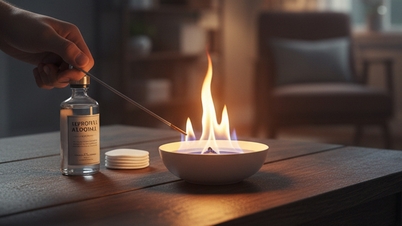
Bread with pate, butter and sausage is a familiar breakfast food of Vietnamese people.
After a series of food poisoning cases related to pate sandwiches, food safety experts warn that many businesses still do not fully understand the process of preserving easily contaminated ingredients such as margarine and pate, which can create the risk of microorganisms, especially Salmonella, entering at any time.
How to preserve butter and cream sauce?
Among them, margarine is commonly used in bakeries to spread on the surface of bread or to make a rich filling. Although it has a longer shelf life than butter, if left at room temperature in a hot and humid environment, butter can still become rancid, separate, or lose its flavor.
According to the instructions of the Food Safety Department, margarine should be stored in the refrigerator, at a temperature below 20°C, away from direct light and air. If the package is opened, it should be tightly closed or put in a clean, covered container to avoid the smell of other foods such as onions, garlic, and fish sauce.
The butter scooping tool must be clean and dry. Do not use the same knife for paté or fresh food to avoid cross-contamination. If the butter has a strange smell, changes color, separates, or shows signs of scum, discard it immediately and do not attempt to use it.
As for mayonnaise (also known as white butter), Associate Professor Dr. Do Van Dung - senior lecturer of the Faculty of Public Health , University of Medicine and Pharmacy, Ho Chi Minh City said that they have the risk of causing food poisoning due to the use of raw eggs (not cooked), so there will be a risk of poisoning if using eggs of unknown origin, contaminated or cracked.
However, in the mayonnaise preparation process, lemon vinegar (acid) is used to emulsify the egg yolks and the acid can inhibit the growth of bacteria.
For these reasons, to reduce the risk of poisoning from Mayonnaise, the following points should be noted:
1: Make sure to use enough acid (acid is to mayonnaise what cooking is to pâté).
2: Store at ideal temperature (if in the refrigerator, do not store for more than 5 days; if taken out and left in the refrigerator, do not store for more than 3 days; and at room temperature, do not store for more than 2 hours).
3: Do not eat if it has a strange smell, is moldy, has changed color or is separated (separation means the emulsification process is not good due to lack of acid).
How to preserve pate
Regarding pate, Associate Professor Dr. Dung said that this is an environment with many nutrients, high humidity and pH suitable for bacteria to grow, so it can easily cause food poisoning.
In addition, pate made from liver and poultry meat products is easily contaminated and has bacteria if not cooked, and can easily cause bacteria to grow if left at room temperature (especially in tropical climates like Vietnam) for a long time.
Therefore, to reduce the risk of food poisoning due to pate in the family, in addition to the hygiene principles as with all other foods (such as ensuring all tools such as blenders, bowls, whisks), the hands of the processor must be clean and dry, use food of safe origin, not damaged, avoid cross-contamination between raw and cooked food, it is important to note: ensure the pate is steamed completely.
Store at ideal temperature (if in the refrigerator, do not store for more than 5 days; if taken out and left in the refrigerator, do not store for more than 3 days; and at room temperature, do not store for more than 1 day). In particular, do not eat if the pate shows signs of color change or strange taste.
Source: https://tuoitre.vn/an-banh-mi-can-biet-cach-bao-quan-bo-pate-an-toan-tranh-nhiem-khuan-2025111121214447.htm



![[Photo] Prime Minister Pham Minh Chinh receives Lao Minister of Labor and Welfare Phosay Sayasone](https://vphoto.vietnam.vn/thumb/1200x675/vietnam/resource/IMAGE/2025/11/11/1762872028311_dsc-2246-jpg.webp)



































































































![Dong Nai OCOP transition: [Article 3] Linking tourism with OCOP product consumption](https://vphoto.vietnam.vn/thumb/402x226/vietnam/resource/IMAGE/2025/11/10/1762739199309_1324-2740-7_n-162543_981.jpeg)








Comment (0)